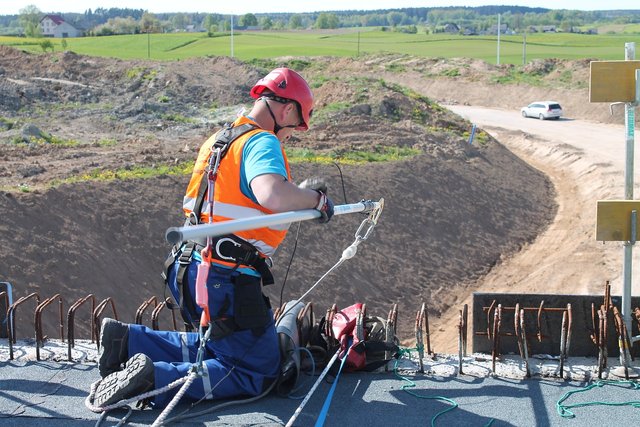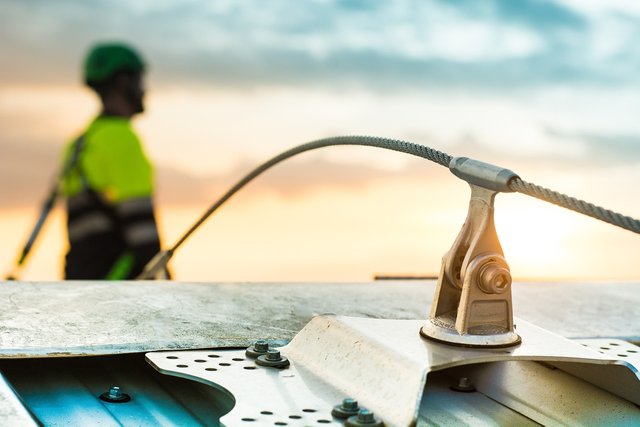Roof Anchor Points - Height Safety: Everything You Need To Know

If you're in the construction industry, maintenance sector, or any business that involves working at height, you already know that ensuring the well-being of yourself and your workers is non-negotiable! In the busy city of Sydney, with its tall buildings and skyscrapers, paying attention to height safety is even more important.
One key element of height safety is installing reliable roof anchor points. But it’s not always that simple! Understanding the intricacies of roof anchor points and how to use them correctly for the best result is essential for safeguarding our workers and adhering to compliance standards.
If roof anchor points have got you confused, then this is the blog for you! We’re going to cover everything you need to know about roof anchor points. From their fundamental importance in ensuring workplace safety to how to choose the right type for your company, we leave no stone unturned. If you’re a business owner just starting out with working at height or just looking to enhance your workplace safety, then read on!
What are Roof Anchor Points?
Roof anchor points, often referred to simply as anchor points, are vital components of a height safety system designed to secure individuals working at elevated positions. These anchorage devices are typically installed on the roof or other elevated surfaces and serve as attachment points for personal fall protection equipment such as harnesses, lanyards, and lifelines.
Roof anchor points are engineered to withstand significant forces and are strategically positioned to provide maximum coverage and accessibility for workers. They come in various forms, including permanent and temporary installations, and are constructed from durable materials that ensure reliability and longevity. There are different types of anchor points, but we’ll talk about that in a moment. These roof safety systems serve as the cornerstone of your fall protection, offering you peace of mind and protection for both you and your workers when working at heights.
Why They Are Important

Roof anchor points play an extremely important role in protecting the safety of those who are working at heights. Serving as secure attachment points for personal fall protection equipment, such as harnesses and lanyards, they are a key part of preventing falls and help minimise the risk of serious injuries or even fatalities! Anchor points allow you and your workers to carry out their tasks with confidence and peace of mind by providing a reliable means of arrest in the event of a fall.
Roof anchor points are also essential for compliance with safety regulations and standards, ensuring businesses meet legal requirements and uphold their duty of care to employees. Beyond regulatory compliance, investing in strong roof anchor point systems demonstrates a commitment to prioritising worker safety, encouraging a culture of accountability and trust within your workplace.
Types Of Roof Anchor Points
Roof anchor points come in various types to suit different work and roof structures. One common type is the permanent roof anchor point, which is usually installed directly onto the roof structure using fasteners such as bolts or screws. These permanent anchors offer a long-term solution and are ideal for buildings with regular maintenance requirements or ongoing work at heights!
Another type is the temporary roof anchor point, which can be easily attached or removed when needed. Temporary anchors are often used in construction or maintenance projects where portability and flexibility are key!
Different designs of roof anchor points are available, including single-point anchors, which provide attachment for one worker, and multi-point anchors, which allow multiple workers to be attached simultaneously. The choice of roof anchor point depends on factors such as the roof type, workload requirements, and specific safety regulations governing your work site. It's essential to select the appropriate type of anchor point and ensure proper installation to maintain safety and compliance standards!
How To Install Properly

Proper installation of roof anchor points is crucial to guarantee their effectiveness in providing a safe working environment at heights. The process begins with a thorough assessment of the roof structure and identification of suitable anchor point locations based on factors such as load-bearing capacity and accessibility.
Once you’ve decided on a location for your anchor point, the roof surface can then be carefully prepared to ensure a secure attachment, which involves cleaning the area as well as removing any debris. Next, the anchor points should be positioned according to manufacturer specifications and securely fastened to the roof structure using appropriate hardware, such as bolts or screws. It's essential to follow installation guidelines provided by the manufacturer and adhere to relevant safety regulations throughout the process!
After installation, a comprehensive inspection must be conducted to verify the integrity of the anchor points and ensure they meet safety standards and they must be certified each year by a professional. By diligently following these steps, you can install roof anchor points and enhance workplace safety for you and your employees!
Maintaining Your Roof Anchor Points
But the roof anchor point journey doesn’t end here! Regular maintenance will be needed to ensure your anchor points preserve their functionality and ensure ongoing safety when working at heights. Regular maintenance procedures should be implemented to inspect, clean, and test the anchor points according to manufacturer guidelines and relevant safety standards. This involves scheduled inspections to check for signs of corrosion, damage or wear that could compromise the integrity of the anchor points.
Any issues identified during inspections should be addressed as quickly as possible through repair or replacement to prevent potential hazards. Keeping the anchor points clean and debris-free is essential to maintain their performance and longevity. Periodic testing of the anchor points, including load testing if required, helps verify their stability and reliability under normal working conditions. Employers should also establish a maintenance schedule and ensure that trained personnel conduct inspections and maintenance tasks following established protocols. By prioritising roof anchor point maintenance, your business can uphold safety standards, mitigate risks, and safeguard the well-being of workers at elevated worksites!
Ensuring Your Safety At Height

So, in today’s blog, we've explored the importance of roof anchor points in ensuring workplace safety, delved into the various types available to suit different jobs, and outlined the crucial steps for proper installation and maintenance! By prioritising the implementation of robust roof anchor points and adhering to established safety protocols, businesses can effectively mitigate risks associated with working at heights and uphold their commitment to employee welfare.
As technology advances and safety regulations evolve, investing in quality roof safety systems and regularly maintaining them remains vital. Remember, when it comes to height safety, a reliable roof anchor point is not just a necessity—it's a lifeline!